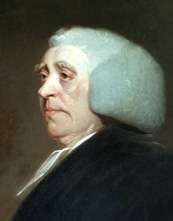Richard Murray (mathematician)
Richard Murray (1725?–1799) was an Irish mathematician and academic, who spent his whole career Trinity College Dublin (TCD), serving both as Erasmus Smith's Professor of Mathematics (1764-1795) and Provost (1795-1799).[1]

Career
Richard Murray was born in County Down, to William Murray (merchant). He matriculated at TCD on 30 May 1743, aged 16, and was a Scholar there in 1745. He was awarded BA (1747), MA and Fellow (1750), BD (1759), and DD (1762). He was Donegall Lecturer in Mathematics (1762–1764), and then became the second Erasmus Smith's Professor of Mathematics (1764-1795). He was also Librarian, was appointed Vice-Provost in 1782, and served as Provost from 1795 until his death.[2]
He is perhaps best remembered for his book Artis logicæ compendium (S. Hooper, 1773), "In usum juventutis collegii Dubliniensis", which was translated in 1852 by John Walker as Murray's Compendium of Logic.
References
- Burtchaell, G. D., and Sadleir, T. U. (eds), Alumni Dublinensis : A Register of the Students, Graduates, Professors and Provosts of Trinity College in the University of Dublin, 1593–1860 (Dublin, 1935) page 608
- Richard Murray. Trinity College Dublin. Retrieved 25 July 2016.
| Academic offices | ||
|---|---|---|
| Preceded by John Hely-Hutchinson |
Provost of Trinity College Dublin 1795–1799 |
Succeeded by John Kearney |